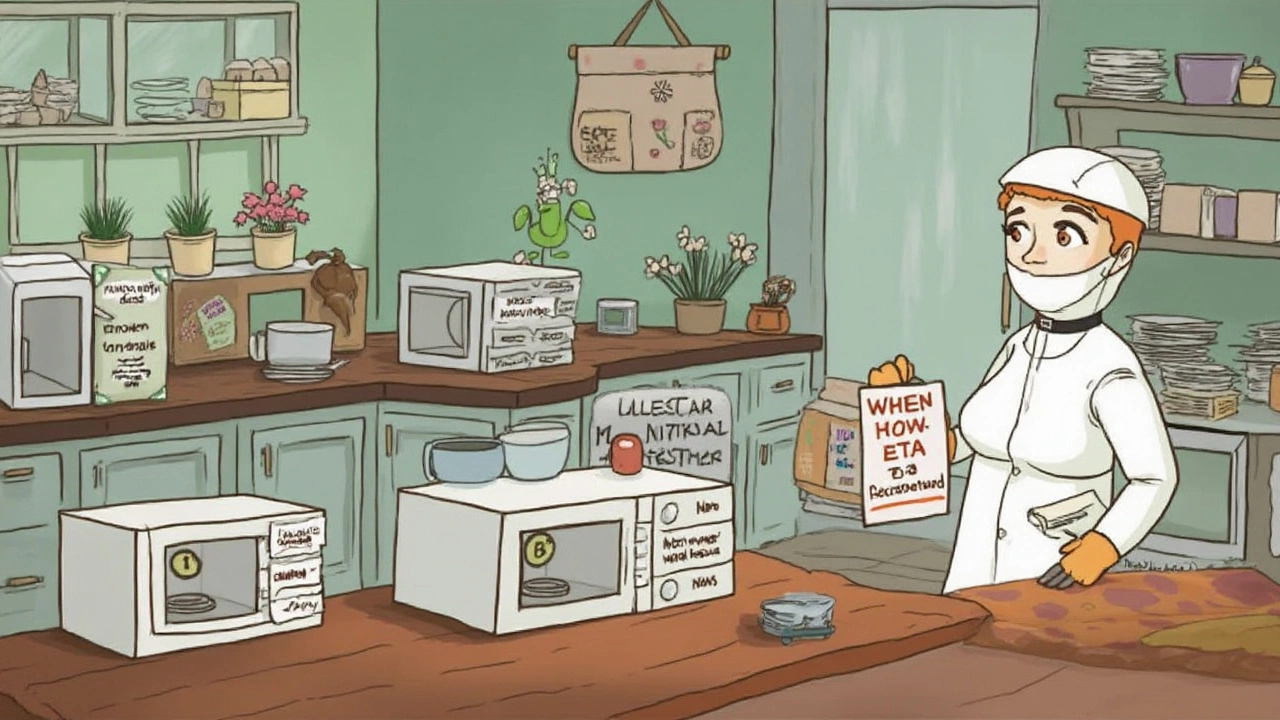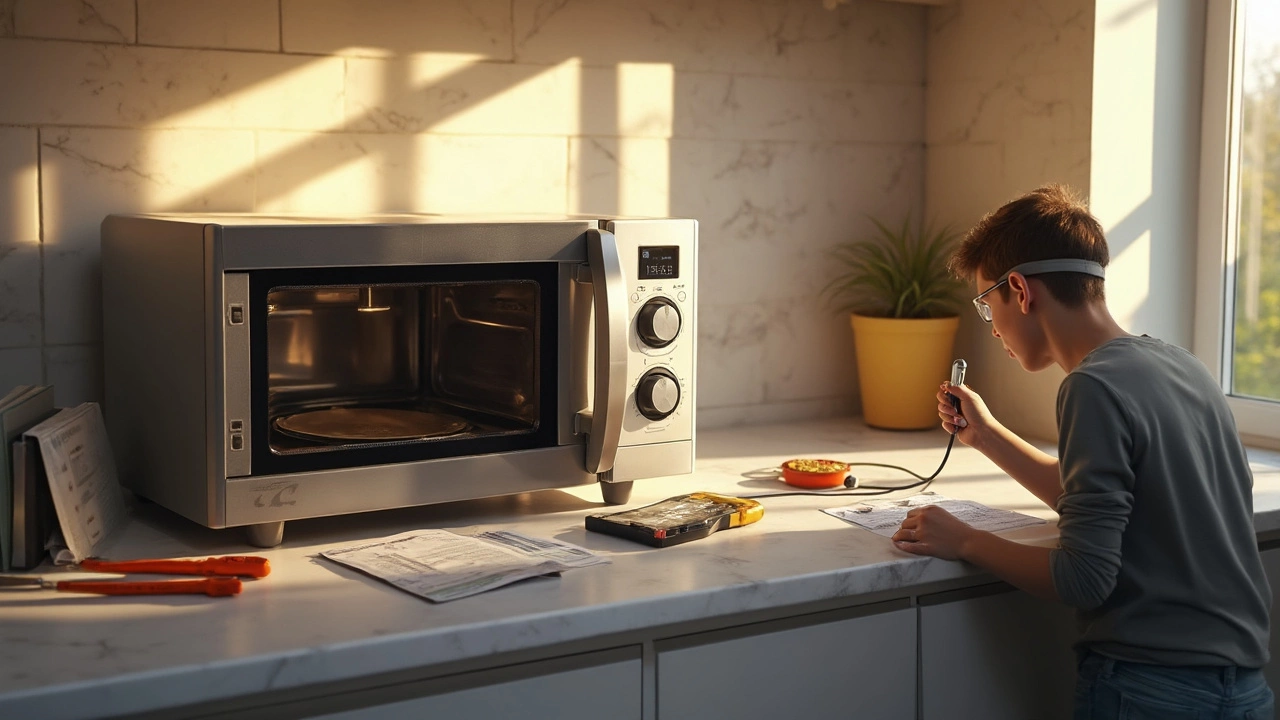Ever looked at a broken microwave and thought, 'How hard can it be'? Well, it turns out, fixing a microwave isn't just about saving a few bucks; there's a bit more at stake. Microwaves are more complex than they seem, packed with high-voltage parts that can give you a nasty shock, even when unplugged.
So, what's inside a microwave that makes it tick—or not tick, as the case may be? At the heart of it, there's a magnetron, which basically converts electrical energy into those heat waves that warm up your leftovers. Sounds simple enough, right? But when things go south, like strange noises or smoke, it's a whole different ball game.
Now, you might be tempted to pop open the cover and have a poke around, but hold on. Understanding the risks, like those hidden electrical dangers, is key. Before you grab a screwdriver, let's get into what you should and shouldn’t do when your trusty kitchen buddy stops cooperating.
- Understanding Microwave Function
- Common Microwave Problems
- Safety Risks Involved
- When to Call a Pro
- DIY Fixes You Can Try
- Microwave Maintenance Tips
Understanding Microwave Function
If you’ve ever wondered what’s really happening when you hit the start button on your microwave, here's the scoop. At the heart of these kitchen wonders is something called a magnetron. It sounds fancy, but its job is straightforward—convert electricity into microwaves. These are a type of electromagnetic wave that makes water molecules in food vibrate, creating heat, which cooks your food.
What’s Inside?
When you look at a microwave, it might seem like it's all about buttons and a spinning glass plate, but there's a lot hidden behind the scenes. Besides the magnetron, there's a high-voltage transformer, which boosts the power to levels needed for cooking. Then, you've got the waveguide, which channels the microwaves from the magnetron into the oven cavity.
And don't forget the control circuits and a cooling fan to keep everything from overheating. Each of these components has a unique role. For example, the waveguide ensures those microwaves are distributed evenly. That’s why you don’t end up with a hot pocket surrounded by freezing edges.
Did You Know?
Here's an interesting tidbit: Microwaves cook food from the outside in, which is why dense foods might need a little extra time to heat through completely. And those rotating turntables? They're there to make sure every inch of your food gets equal exposure to the microwaves.
Fun Fact Table
| Component | Function |
|---|---|
| Magnetron | Generates microwaves |
| Waveguide | Directs microwaves into the oven cavity |
| Turntable | Ensures even cooking |
Understanding how your microwave works can really help you when considering DIY microwave repairs. Knowing what each part does makes it easier to identify problems and understand why some parts shouldn’t be messed with unless you’re a pro.
Common Microwave Problems
Microwaves, like any other appliance, can throw a tantrum or two. They might stop heating your food, make unsettling noises, or just go completely dead. Let's break down some of these common microwave problems and what might actually be going on.
1. Microwave Not Heating
One of the most frustrating issues is when your microwave runs, but the food stays ice cold. This often means the magnetron is kaput. It's the part responsible for heating, and when it burns out (like a light bulb), it won't be heating anything.
2. Strange Noises
Ever thought your microwave was about to take off? These noises can mean anything from a faulty fan to issues with the magnetron or even something stuck inside the microwave adding to the racket.
3. Microwave Door Not Sealing Properly
A microwave door that doesn't shut properly is a big no-no. Not only can this stop the microwave from working, but it also leads to escaping microwaves which is definitely dangerous. The usual suspects here are broken door latches or hinges.
4. Sparking Inside the Microwave
If you see sparks, stop the microwave immediately. Sparks usually mean metal has gotten into the microwave spoiling the works, or the microwave's waveguide cover is damaged.
"Microwave ovens are incredibly useful but most of us don't know much about how they actually operate. Ignoring common problems can lead to bigger issues down the line." — Household Appliance Expert, Jane Doe
5. Keypad Not Working
If you're pounding the buttons and nothing's happening, you might be dealing with a faulty touchpad or control board. This is usually a sign that you need some professional help.
While these issues are some of the most common hurdles in microwave repair, pinpointing the problem can be a little like detective work—sometimes a simple issue hides a bigger one.
Safety Risks Involved
Diving into DIY microwave repair might seem like a daring adventure, but let's get real about the risks. Your microwave isn't just a fancy box that heats food; it's got some potential hazards hiding under the hood.
Electrical Shock
Even when unplugged, a microwave can carry enough charge in its capacitor to give you a severe jolt. We're talking about volts that can knock you sideways, or worse. Safety gear won't always cut it, and unless you're a trained technician, those high-voltage parts aren't something you want to mess with.
Radiation Exposure
Sure, a working microwave is safe, but when you're poking around inside, things can change fast. Microwaves use radiation to cook, and an improperly reassembled unit might leak those microwaves, which is definitely on the 'not safe' list.
Fire Hazards
Short circuits and other electrical faults can lead to fires. It sounds dramatic, but it's a genuine risk if you accidentally cross wires or reconnect components incorrectly. Plus, homemade fixes might bypass safety checks that professional repairs ensure.
- DIY microwave attempts can void warranties, which could've covered safer fixes.
- Improper handling often results in damaging other components, leading to costlier repairs.
- Without the right tools, diagnosing and fixing the right issue is a shot in the dark.
So, while the allure of fixing your own microwave is real, seriously consider these risks. It's not just about getting the thing to zap your pizza again; it's about doing it without any sparks flying—all puns intended.

When to Call a Pro
Okay, so you're staring at your malfunctioning microwave and wondering if it's time to give up and call a professional. Here’s the lowdown on when you should step back and dial a number.
Major Electrical Issues
If your microwave is tripping the circuit breaker or giving off a burning smell, it’s a red flag. These issues usually indicate a serious electrical problem that requires a pro. Tackling it yourself can lead to shocks, or worse, starting a fire. Better safe than sorry, right?
Strange Noises or Sparks
Weird grinding noises or visible sparking inside the unit aren't just annoying—they're dangerous. These can be signs of failing components like the magnetron or high-voltage capacitor. Only trained technicians should mess with these parts because they have the right tools and expertise.
Structural Damage
A cracked door or a damaged seal might not seem like a big deal but can lead to radiation leaks. Radiation isn't something you want to play with; safety tips will only get you so far with this one. A professional can effectively handle these parts to ensure everything meets safety standards.
Warranty Still Active
If your microwave is still under warranty, attempting a DIY microwave repair can void it. Most manufacturers cover specific repairs, so it’s best to use their authorized service centers. Why waste money when the service might be free?
| Issue | Recommended Action |
|---|---|
| Electrical Problems | Call a professional |
| Noises/Sparks | Call a professional |
| Structural Damage | Call a professional |
| Warranty Considerations | Check with manufacturer |
In a nutshell, when your microwave acts up, don't hesitate to call in a pro when needed. This choice can save you from unnecessary danger and possibly extend the lifespan of your appliance.
DIY Fixes You Can Try
Alright, if you're feeling a bit adventurous and want to tackle some microwave repair yourself, there are a few things you can safely attempt. But remember, safety first—unplug that microwave!
Simple Cleaning Hacks
The most common issue with microwaves is usually performance-related and can often be fixed with a good clean. Grease and food particles can build up, especially around the door seal, affecting performance. Grab a damp cloth with some mild detergent and wipe down all surfaces, focusing on the door seals.
Troubleshooting Power Issues
If your microwave isn't turning on, first check the outlet by plugging in another device to see if it works. Sometimes, it's as simple as a tripped circuit breaker.
Replacing the Turntable Motor
So, your microwave turntable isn't spinning? You might need to replace the turntable motor. Here's how you can do it:
- Unplug your microwave.
- Remove the plate and roller from inside the microwave.
- Flip the microwave over to access the motor, usually located underneath.
- Unscrew the motor and disconnect the wires (make sure you note how they're connected).
- Install the new motor by reconnecting the wires and screwing it back into place.
- Flip it back, put the roller and plate back in, then plug it in and test it out.
Fixing a Sparkling Microwave
If your microwave starts sparking, it might be due to a faulty waveguide cover, which is there to protect the electronics from splatters. It's an easy fix—just order a replacement online and swap it out.
These are small adjustments you can make without needing too much technical know-how, but always be cautious. If you're not sure about something, it might be best to bring in a pro. DIY is great until it’s not safe, and with microwaves, safety's the name of the game. Don't take chances with something that's meant to be fast and convenient in your life!
Microwave Maintenance Tips
Keeping your microwave in tip-top shape isn't as hard as it sounds. A little regular maintenance can go a long way in preventing pesky breakdowns and maybe even save you a call to the repair guy.
Keep It Clean
This might sound like a no-brainer, but you’d be surprised how much grunge can build up inside. Food splatters and spills can burn out the microwave's performance over time. A quick wipe-down after each use with a damp cloth will do wonders.
- Use a mix of water and vinegar to cut through any stubborn grease.
- Ensure you dry thoroughly to prevent moisture from causing any damage.
Don't Overload It
It’s tempting to cram in that extra plate, but microwaves have their limits. Overloading can cause damage to the magnetron, which is a costly fix.
Mind the Door
Slamming the microwave door can mess up the alignment, leading to issues over time. Close it gently; your microwave will thank you!
Inspect the Seal
The door seal is crucial for keeping those microwaves inside where they belong. Occasionally check to make sure it’s clean and not cracked.
Use Microwave-Safe Containers
Not all plastics and glass can handle the heat. Only use containers labeled microwave-safe to avoid melting mishaps.
Pay Attention to Noises
If your microwave starts making funny sounds, it might be time to investigate further. Ignoring it can lead to bigger issues, so don’t just hit snooze on those sounds.
With these simple maintenance tips, you can keep your microwave humming along smoothly and extend its life. A little attention here and there can help prevent a kitchen catastrophe later on.


